Understanding the Root of Conflict Through the B.A.N.K. Lens
Most communication errors begin at the point of misunderstanding, not disagreement.
In the field, conflict rarely erupts over facts. It stems from misaligned values, unmet expectations, and the unspoken rules of how people believe the world should work. When two people operate from different value systems, and neither knows how to identify or bridge that gap, conflict unfortunately becomes inevitable.
That’s where B.A.N.K.™ becomes essential. This personality profiling system teaches that every individual makes decisions (including whether to engage, retreat, or resist) based on four distinct personality types: Blueprint, Action, Nurturing, and Knowledge. Each of these types is driven by 12 core values.
If you don’t know what someone values, you won’t understand what they’re defending in a conflict. That’s not guesswork, it’s science-backed training, used by top performers to increase connection, reduce friction, and resolve communication failures faster than conventional methods.
In sales, leadership, or even personal relationships, resolving conflict starts with cracking the code of what your counterpart values most.
Key Takeaways
-
Conflict is caused by clashing values, not clashing personalities. When someone feels disrespected, it’s usually because their core values were violated, not necessarily because you “disagreed.”
-
Code-based communication resolves tension in real time. Adapting your language to match someone’s B.A.N.K. profile immediately lowers defensiveness and increases collaboration.
-
What calms one code may escalate another. One-size-fits-all advice like “just stay calm” doesn’t work when Blueprint needs order, but Action needs urgency.
-
B.A.N.K. helps you get back to clarity — fast. Whether in sales, leadership, or personal relationships, it gives you the tools to decode, de-escalate, and connect under pressure.
Let’s move forward and examine what actually drives conflict (and why most people get it dead wrong).
It’s About Values, Not Behavior
Let’s challenge the default assumption here. Conflict doesn’t happen because two people disagree, It happens because they don’t recognize why they disagree.
At its root, conflict is a defense mechanism, a reaction to having one’s core values violated. According to the B.A.N.K. Fundamentals™, each of the four personality codes is anchored by their own unique, distinct values. These values aren’t preferences either, they’re non-negotiables.
When someone raises their voice, withdraws from a conversation, or becomes argumentative, they’re not just “being difficult.” They’re protecting the invisible framework that shapes how they expect the world to work. The moment another person’s language, behavior, or decision contradicts those values, friction sparks.
Here’s the craziest part: most people don’t even realize they’re stepping on values. If they do, they assume everyone shares the same ones. That’s a myth, and it’s why “conflict resolution” often becomes a cycle of repeating the same mistakes with different people.
B.A.N.K. gives you the toolset to identify what is being protected, who is most likely to be triggered by specific behavior, and how to shift the conversation to meet the person where they are.
So the next time a conversation turns tense, the question isn’t “What did I say wrong?” The question is, “Whose values did I ignore?”
Miscommunication costs more than time , it costs trust.
Book a personalized training session with The CodeMasters and let us help you apply B.A.N.K. to your team, your business, or your leadership style today.
How Each Code Responds to Conflict
If you’ve ever walked away from a heated exchange thinking, “Well, that escalated fast” it’s likely because you triggered a value you didn’t realize the other person held dear.
The B.A.N.K. codes don’t just shape how people sell or buy. They also shape how they fight, freeze, or fix conflict. Knowing which values each code defends lets you adjust your approach, avoid unintentional offense, and de-escalate with clarity.
Each personality type in the system is anchored by 12 core values:
-
Blueprint Values: Stability, structure, systems, rules, responsibility, planning, predictability, order, discipline, organization, tradition, budget
-
Action Values: Freedom, flexibility, excitement, opportunity, spontaneity, competition, risk-taking, fun, influence, lifestyle, image, adventure
-
Nurturing Values: Loyalty, authenticity, community, relationships, connection, compassion, ethics, contribution, support, service, harmony, sincerity
-
Knowledge Values: Intelligence, logic, mastery, expertise, innovation, accuracy, research, autonomy, self-sufficiency, learning, science, technology
Blueprint: Conflict Arises From Chaos
Core Values: Structure, responsibility, planning, punctuality, rules Triggers: Missed deadlines, unexpected changes, vague instructions, unprofessional behavior
What Resolves It: Clear steps, logical reasoning, respect for their time and systems
Your role in resolution: Be organized. Speak in timelines. Re-establish trust by restoring order.
Action: Conflict Arises From Control
Core Values: Freedom, excitement, opportunity, flexibility, influence Triggers: Micromanagement, slow decision-making, detailed breakdowns, constraints
What Resolves It: Options, fast pacing, energy, and room to move
Your role in resolution: Skip the backstory. Get to the point. Offer them a choice and let them lead.
Nurture: Conflict Arises From Disconnection
Core Values: Loyalty, ethics, sincerity, contribution, community Triggers: Cold logic, dismissal, insincerity, lack of inclusion
What Resolves It: Empathy, acknowledgment, collaboration, meaningful purpose
Your role in resolution: Show heart. Ask how they feel. Remind them they matter ( not just their role).
Knowledge: Conflict Arises From Inaccuracy
Core Values: Logic, mastery, autonomy, intelligence, research Triggers: Exaggeration, fluff, rushed decisions, emotional reasoning
What Resolves It: Data, rational argument, independent space to evaluate
Your role in resolution: Slow down. Present the facts. Let them come to their own conclusion.
Putting It All Together
The power of B.A.N.K. lies within its adaptability. No two conversations should sound the same, because no two codes respond to conflict the same way. The more fluently you speak across all four codes, the more equipped you are to resolve tension before it ever becomes a problem.
Recall the last disagreement you had, and imagine how different it would have gone if you had their code in your hand. This is what we teach every day at The Codemasters.
Schedule a strategy session with us today and learn how to lead conversations that create alignment, every time.
How to Use Code-Switching in Real Time
The best communicators don’t just speak, they shift. They read the room, recognize the code, and adjust their language mid-conversation.
We call it code-switching, and it’s one of the most effective conflict resolution skills taught inside the B.A.N.K. system.
I’d like to be very clear, code-switching isn’t manipulation. It’s adaptation with integrity. You’re not changing your message, just changing your delivery so it lands.
Here’s what real-time code-switching looks like in a tense moment:
-
You start to notice a Blueprint client pushing back — not because of your idea, but because you’re not showing them the structure behind it. You pivot: “Let me walk you through the step-by-step plan.”
-
An Action team member is visibly disengaged during a conflict resolution meeting. You adjust your tone: “Let’s cut to the chase. Here are your options. What feels right?”
-
A Nurturing colleague gets quiet after a firm comment. You recalibrate: “I want to make sure you know this isn’t personal in any way. You matter here.”
-
A Knowledge stakeholder starts questioning your data. You reframe: “Here are the sources we used, I’ll send them to you so you can dig in.”
You’re not reacting emotionally, simply adjusting strategically.
When done well, code-switching instantly lowers resistance because the other person hears the message in their language.
B.A.N.K. isn’t just a tool, it’s a real-time skillset. One that elevates leaders and strengthens teams.
If you’re ready to master resolving conflict in the moment, not after the fallout, book a training with The CodeMasters today.
Conflict Is Inevitable but Miscommunication Doesn’t Have to Be
The truth of the matter is conflict will always exist in leadership, sales, teams, and relationships. Every day, people walk away from conversations feeling frustrated, unheard, or misunderstood. It’s not because the issue was unsolvable, but because the real values at play were never named, respected, or addressed.
That’s the frustrating communication gap that B.A.N.K. closes.
When you understand someone’s code, you’re not just guessing their intentions. You’re reading the logic behind their decisions, their defensiveness, and their demands. You’re no longer navigating blind, you’re responding with precision.
Whether you’re leading a team, closing a deal, coaching a client, or managing personal relationships, the ability to de-escalate quickly and with language that resonates is a powerful skill. One that separates high-performing communicators from everyone else.
B.A.N.K. equips you with that edge. Not as a theory, but as a practical, proven system.
Train with The CodeMasters and equip yourself with the ability to lead, communicate, and resolve with mastery.
People Also Ask
Q: Is B.A.N.K. useful for conflict resolution in personal relationships?
A: Absolutely. Many users apply B.A.N.K. to marriages, parenting, and friendships to reduce misunderstandings and build deeper connections.
Q: How fast can someone learn to use the B.A.N.K. method?
A: With proper training, you can begin applying B.A.N.K. principles in as little as one session. Mastery comes through practice and live coaching.
Q: What tools do The Codemasters offer beyond live training?
A: The Codemasters offer workshops, consulting, and access to B.A.N.K. PASS™ — a digital tool that helps you instantly identify personality codes.


Leave A Comment